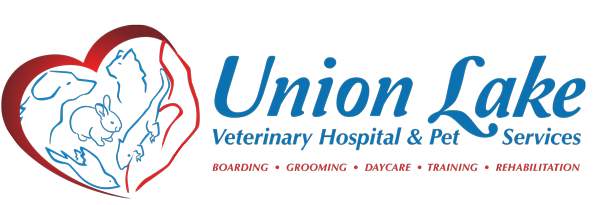Does your dog or cat experience fear of the vet or anxiety at the vet’s office? Many don’t but, according to a 2014 Bayer Veterinary Healthcare Usage study, 37 percent of dog owners and a whopping 58 percent of cat owners report that their pets fear going to the veterinarian–just as many of us dread a visit to our doctor.
Despite our gentle manner, snuggles and generous treats, it makes sense. The strange noises, smells, and sights combine with their perception of being “poked and prodded”. Add that to any negative associations from emergency or sickness visits, and it spook even the most laid-back pet.
At Union Lake Veterinary Hospital, we believe all pets deserve access to regular, quality health care. We are working to make visits to our practice as comfortable as possible for our furry patients by implementing new Fear Free Initiative techniques in our practice.
The Fear Free Movement
Dr. Marty Becker, DVM, started the Fear Free Initiative after seeing a need to address the emotional wellbeing of our patients as well as their physical health. This meant changing the way veterinary practices handle patient visits. 160 veterinary and animal behavior experts make up the panel of professionals who is designing best practices for handling and interacting with pets to help them feel more at ease during their vet visits.
A new Fear Free certification program is designed to teach practitioners the principles of gentle handling, focusing on recognizing the signs of fear in pets by reading their body language and other signals. With gentle touch and by creating positive environmental associations within our practice, we can undo a lot of the damage caused by previous, stressful visits to the vet.
Helping Pets With A Fear Of The Vet At ULVH
At ULVH, we are working to help pets feel more calm and comfortable with a combination of positive sensory associations (treats and toys), a soothing environment (playing of pet-approved music shown to reduce stress, quiet areas, low-stress exam rooms with fewer anxiety triggers and more comfort), the use of soothing Feliway and dog-appeasing pheromones or calming medications, and low-stress techniques (slow, gentle, use of stress-free restraint when necessary).
In addition, our team of trainers has a positive-based program for pets who have excessive fear of the vet to help them reduce or get past their fear of a vet visit.
Several of our practitioners are currently enrolled in the Fear Free certification program, including Val Olmstead and Amber Dennis. Dr. Hawker is planning to enroll soon. And we want to be one of the first Fear Free certified practices when they roll out a practice-level certification later in the year.
Reducing Stress Begins With You
The likelihood is that most pets experience some level of fear at the veterinarian’s office, even if he or she isn’t showing it. Like people, pets have a physical response to stress and fear, and over time it can have negative health consequences.
Your pet’s fight or flight response to stress might begin before you are even out the door. Try our tips for alleviating your pet’s anxiety before his or her next appointment:
- Create a positive association for your cat with his or her carrier. Leave the carrier out where kitty spends time, provide food, treats, and toys in the carrier.
- Get your pet acclimated to car rides by taking short trips around the block, and providing a reward afterward. Slowly increase the duration of the trip until your pet is comfortable riding in the car. For dogs especially, not every car ride should be to the vet.
- Refrain from using “baby talk” with your pet, as it can increase his or her stress as well as yours.
If you have any questions about the principals of a Fear-Free practice, don’t hesitate to contact us. And we look forward to a calmer, more comfortable next visit for you and your pet!

